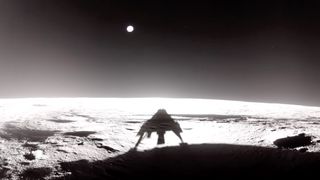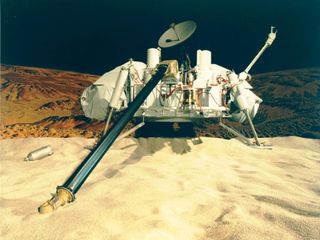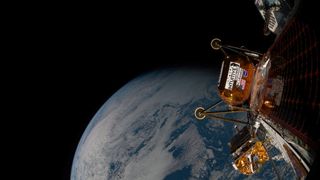This article was originally published at The Conversation. The publication contributed the article to Space.com’s Expert Voices: Op-Ed & Insights. María Rosa Pino Otín is a Professor and researcher of Microbiology, Universidad San Jorge We often forget how wonderful it is that life exists, and what a special and unique phenomenon it is. As far as we know, ours is the only planet capable of supporting life, and it seems to have arisen in the form of something like today’s single-celled prokaryotic organisms. However, scientists have not given up hope…
Read MoreTag: Solar System
Scientists discover Earth’s oldest impact crater in Australia
Geologists have discovered the world’s oldest known impact crater; it sits in the heart of Western Australia’s ancient Pilbara region. An analysis of rock layers in the region suggests a crater at least 62 miles (100 kilometers) wide was carved after a large space rock struck Earth roughly 3.47 billion years ago, when our planet was almost completely covered in water. The discovery pushes back the record for the oldest impact crater on Earth by more than 1 billion years — the previous record holder, the Yarrabubba impact structure, also…
Read MoreTouch down on the moon with private Blue Ghost lander in this amazing video
Blue Ghost had its eyes wide open during its epic moon landing last weekend. On Sunday (March 2), Blue Ghost — built and operated by the Texas-based company Firefly Aerospace — became just the second private spacecraft ever to soft-land on the moon, coming to rest in the near side’s Mare Crisium (“Sea of Crises”) region. We can now relive Blue Ghost’s historic descent, thanks to stunning footage captured by the lander. Firefly Aerospace’s Blue Ghost lunar lander captured this shot of its own shadow on the moon just after…
Read MoreSee Earth shine like a Blue Marble in this stunning photo by Japan’s private Resilience moon lander
The private Resilience moon lander now has a target touchdown date. The Tokyo-based company ispace, which built and operates Resilience, announced Monday (March 3) that it’s eyeing June 5 for the spacecraft’s lunar touchdown attempt. The current plan calls for Resilience to land that day at 3:24 p.m. EST (2024 GMT) near the center of Mare Frigoris (“Sea of Cold”), a basaltic plain in the moon‘s northern reaches. But that’s not set in stone. An image of Earth taken by the private Resilience lunar lander on Feb. 18, 2025. (Image…
Read MoreSunrise on the moon! Private Blue Ghost lander captures amazing shot after historic lunar touchdown (photo)
Firefly Aerospace’s Blue Ghost lander has captured a gorgeous shot of sunrise on the moon as it begins its workday on the lunar surface. Blue Ghost aced its lunar landing attempt on Sunday (March 2), setting down close to Mons Latreille, a solitary lunar peak in the vast basin Mare Crisium (“Sea of Crises”) in the northeastern region of the moon’s near side. And the spacecraft is already getting to work, starting up its science payloads and capturing amazing images of its surroundings and the distant Earth from the lunar…
Read MoreIs it time to revisit what NASA’s Viking lander found on Mars in 1976?
Back in 1976, the dual NASA Viking landers came to full stop on the Red Planet. Their life detection experimental findings still reverberate within the scientific community – fueling the on-going discussion on a key question: Is there life on Mars? Fast forward to today, a new paper tackles and reconsiders the results of the Viking Biology experiments. Perchlorate finding The most significant change since those 1970’s experiments were conducted was the discovery of high levels of perchlorate on Mars. Perchlorate, plus abiotic oxidants, explains the Viking results and there…
Read MoreScientists warn of consequences as over 800 NOAA workers are fired: ‘Censoring science does not change the facts’
Scientists warn that the Trump administration’s abrupt firing of hundreds of weather forecasters and climate experts across NOAA will curtail important climate research and could result in preventable deaths during extreme weather events and related disasters. Over 800 employees across most divisions of the National Oceanic and Atmospheric Administration (NOAA) — a premier U.S. federal agency at the forefront of climate research that provides timely weather forecasts to the public for free — were dismissed in mass layoffs that began Thursday afternoon (Feb. 27). The cuts targeted probationary employees, a…
Read MorePrivate Athena moon lander beams home gorgeous views of Earth from space (photos)
A newly launched lunar lander just captured some stunning shots of its home planet. Athena, the second moon lander from Houston-based company Intuitive Machines, launched atop a SpaceX Falcon 9 rocket from Florida’s Space Coast on Wednesday evening (Feb. 26). Shortly after deploying into the final frontier, Athena snapped a few selfies with Earth in the background, including one that shows the Falcon 9‘s upper stage drifting in the void beneath the lander. (Bright specks visible near the rocket stage may be some of the other payloads that launched with…
Read MorePrivate Blue Ghost lander sees far side of the moon in breathtaking detail ahead of lunar landing (video)
Firefly Aerospace’s Blue Ghost lunar lander is sharing some amazing views from just above the moon. Blue Ghost beamed home gorgeous, up-close shots of the moon‘s far side on Feb. 24, just after lowering its orbit ahead of a Sunday morning (March 2) landing attempt. “That feeling you get when you look out the window and realize you’re almost home!” Texas-based Firefly wrote in a Feb. 26 X post, which shared a 93-second video of the Blue Ghost footage. Firefly Aerospace’s Blue Ghost lunar lander snapped this shot of the…
Read MoreJapan’s Resilience moon lander aces lunar flyby ahead of historic touchdown try (photo)
The private Resilience lunar lander just got its first up-close look at the moon. Resilience, which was built by Japanese company ispace, aced a flyby of the moon on Friday evening (Feb. 14), coming within a mere 5,220 miles (8,400 kilometers) of Earth’s nearest neighbor. The lander memorialized the milestone with a photo, snapping a nice shot of the battered lunar surface from a distance of 8,972 miles (14,439 km). The close encounter was “a historic first of its type for a Japanese private, commercial lunar lander,” according to ispace.…
Read More








